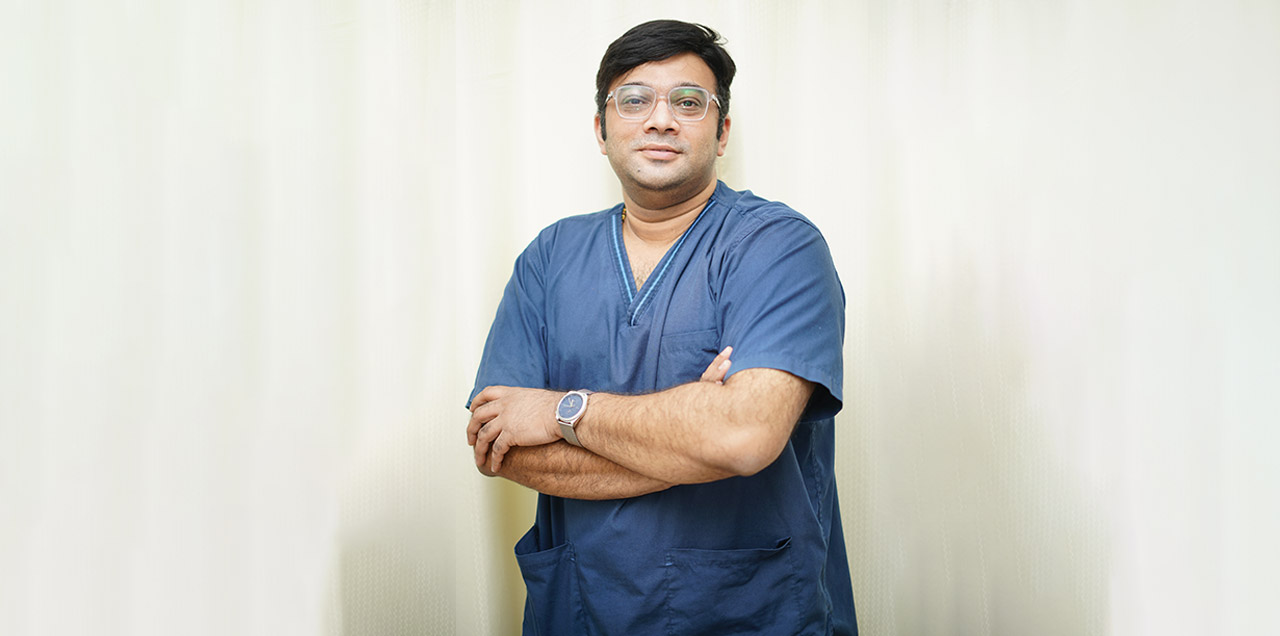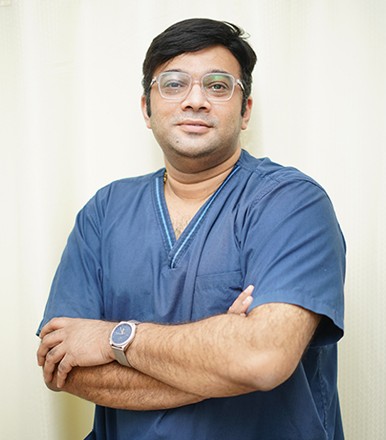We here at HFM seek great minds and field experts to share their extensive knowledge and experience with our readers. In a recent conversation, we had the pleasure of speaking with Dr. Manish Saini, the esteemed Head of the Department of Arthroscopy and Sports Injuries at Shalby Hospital Surat. Dr. Saini's presence is marked by a radiant smile and an unwavering confidence that we are sure, immediately puts his patients at ease. With an impressive career that includes working at the Sports Injury Centre, Safdarjung Hospital Delhi, and treating thousands of athletes, military personnel, and citizens across India, Dr. Saini brings unparalleled expertise to his role. His experience, which spans over 10,000 surgeries on the knee, hip, shoulder, and ankle, underscores his commitment to excellence in the field of arthroscopic surgery. Let's dig into an insightful interactive session about this amazing surgeon and his specialized technique.
What inspired you to become an arthroscopic surgeon?
I believe strongly in destiny. I believe it was laid down since childhood. My father was a government pharmacist, he had always dreamt for us to become a doctor. And this interest in biology was inculcated since the beginning. And so I get to go through merit and am destined to pass MBBS through the prestigious MAMC, Delhi University. If we talk about choosing the specialization, It was in my 3rd-year MBBS posting when I went to see an orthopaedic surgeon. I saw big build people doing lots of metalwork, Hammering, drilling, pulling, and pushing. That gave me an instant adrenaline rush and I realized I was made for orthopaedic surgery only. Took that instinctive decision, Stars were on my side, and I was accepted into the MS Orthopedics program at Lady Hardinge Medical College, Delhi University, on my first attempt. The national and international training in joint replacement and arthroscopy came later in the course.
What developments in arthroscopic surgery have you found most exciting during your career and any challenging case that you’ve worked on?
Arthroscopic surgeries are the latest invention in the orthopaedic sector so far. These surgeries represent a significant advancement in the field of orthopaedics. Since its initial inception, this minimally invasive surgical technique has been continually refined and adapted for use in various joint procedures. Every few months, new surgical techniques and biological modifiers are introduced, contributing to significant advancements in the field. The primary focus of these developments is to preserve and protect natural joints for patients, embodying the promising ideology of orthopaedic care.
A surgeon's life is never short of challenges and expectations. Performing complex knee and shoulder arthroscopic procedures presents a continuous stream of new challenges due to the unique presentation of each case in terms of morphology, ergonomics, and biological restoration. Despite the daunting nature of these challenges, I am grateful for the extensive experience gained from the journey thus far. As a result, unexpected or seemingly impossible challenges no longer intimidate us.
How do you define sports injuries and the Arthroscopic department. ? What injuries are covered under this treatment? Who benefits the most from this technique?
There are two terms here sports injuries and arthroscopic. Sports injury is a wide term. There is a misconception that these injuries happen only to those who play sports. But that’s not true. People involved in dancing, and doing household activities can also get these injuries and the technique to treat them is called arthroscopy. That's our second term, it’s a keyhole technique that is useful in treating any injury related to muscles and joints.
All those injuries which involve the muscular-skeletal system and not the factures come under this. Those injuries that involve ligaments or meniscus tears are treated with arthroscopy. So, we can say all those muscle and joint injury which does not involve fracture comes under the sports injuries and treated with arthroscopy.
The keyhole arthroscopy technique is highly beneficial for treating elderly individuals with arthritic joints. This method is particularly helpful for addressing shoulder issues, as it allows for easier muscle repair and helps individuals avoid the need for replacement surgeries. Elderly individuals often struggle with daily activities such as dressing themselves and combing their hair due to the impact of arthritis on their shoulder muscles, making this technique especially valuable for improving their quality of life.
What is a knee meniscus tear? What is the impact and importance of such surgeries?
The knee meniscus is a very important structure and, unfortunately, people do not understand the importance of it and they do not come to the doctor in their initial stages. when the knee meniscus gets damaged you hear the popping sound from the joint that’s when you consult the doctor and get all the scans and diagnosis. It is very important to treat that in the early stage because if not it will result in joint arthritis and eventually would require a knee replacement. To avoid all the hustle it is important to get a meniscus tear repair. I’ll tell you a way to identify it. The purpose of the knee ligament is to balance the joint, it’s a supportive structure once it gets damaged the patient feels that their joints are not strong enough they feel no confidence in running and doing sports activities. That’s when you give attention to it. And if you don’t treat it on time unfortunately the joints become arthritic. If you feel weak in joints, don’t ignore it, that is the time you consult a doctor.
In your opinion, what are the most significant advancements in arthroscopic surgical techniques in recent years?
Arthroscopic surgery is fantastic in a way. In all of our surgeries, we typically have a full view of the operating area from all angles. However, in arthroscopic surgery, we're limited to only two dimensions on a TV monitor. The third dimension is something that we have to visualize in our minds, accompanied by the sense of touch from the probe. The recent introduction of a 3D system in arthroscopy has certainly made the process a bit more manageable. It's important to note that extensive training is crucial for anyone looking to perform arthroscopic surgery. Unlike some other procedures, simply assisting or observing isn't an effective way to learn arthroscopy.
How do you balance staying up-to-date with the latest advancements while maintaining a focus on providing excellent patient care?
I am a member of various international Society of Arthroscopy. That keeps me updated. Also, I make sure that I keep on brushing old books from time to time and be regular with new advancements and scientific texts.
What are some common misconceptions about arthroscopic surgery that you encounter, and how do you address them?
Arthroscopic surgeries are often mistakenly associated solely with athletes, but this is not the case. These procedures are also performed for various other reasons, such as accidental falls at home or outdoors, injuries from road accidents, and sports-related injuries. Additionally, elderly patients may require these procedures due to age-related damage to shoulder muscles, similar to how cataract surgeries are necessary for age-related vision issues.
What do you see as the future of arthroscopic surgery and sports medicine?
Because the future of Sports is bright. So is the future of arthroscopy and Sports medicine. People are much inclined about Sports and aware of injuries that can be well sorted completely. So it's not the end of the career for any athlete. Arthroscopy deals with salvaging the joint which everyone thinks and favors about preserving the natural joint and not getting them replaced at an early age. And if we see the future in terms of technologies and surgeries, meniscus transplant, cartilage repair and restoration, and orthobiologics are arthroscopy's future now.
How do you ensure that your patients feel comfortable and confident in your care?
It is crucial to personally meet with the patient in the OPD. Rather than relying solely on reports, it is essential to diagnose their condition through a clinical evaluation. After all, our primary focus is to treat the patient, not just the test results. Providing counseling to patients is of utmost importance. It is essential to build trust and confidence with the patient by thoroughly explaining the necessity of surgery and detailing the procedure from start to finish. It's important to remember that entrusting someone to perform a surgical procedure is the highest level of trust, and it is our responsibility to meet and exceed those expectations every time.
What’s the importance of physiotherapy rehab in sports injury?
Physiotherapy is paramount in treating these sports injuries because when you have operated a patient you do the rehabs in three phases. In 1st phase, you focus on all the stretching exercises to achieve the range, in the 2nd phase you work on strengthening the muscles and in the 3rd phase which is most important, especially for the athlete where balancing exercises are done. I would say no injury can be treated completely without a good physiotherapy treatment on a scientific protocol.
What advice do you give our readers to keep healthy joints?
Those with healthy joints can perform every activity effortlessly they just have to ensure correct posture and limited exertion of joints. My advice is that those who have joint and muscle problems, face difficulty while performing sports or doing squats, etc., should not do it. They should not do lunges, they should not run. These people are advised to perform off-load exercises like swimming and cycling as the joints are not under pressure.
HFM got the insights of arthroscopy from the field expert himself. Dr Saini’s radiant smile and unwavering confidence result from his years of experience. We can surely say that this man is ace in his work and he loves doing it.
Wish you get very old with the healthiest joints and muscles ever, and if you get any issues, you know whom to consult. Toddles!





